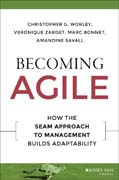
Becoming Agile: How the SEAM Approach to Management Builds Adaptability
Worley, Christopher G.
Zardet, Veronique
Bonnet, Marc
Savall, Amandine
An in–depth example of The Agility Factor in action Becoming Agile: How the SEAM Approach to Management Builds Adaptability illustrates the process of becoming an agile organization. Reflecting the principles presented in The Agility Factor, readers are taken on a real–world journey of transformation and change. This short–format case study of the French company Brioche Pasquier highlights how one organization successfully implemented the principles of agility using the socio–economic approach to management, detailing each step of the process and describing how every decision brought the goal closer within reach. Readers get inside the heads of decision makers to gain insight into how tough decisions were made, how new, important, and flexible management tools were implemented, and how the necessary changes ultimately benefitted both the organization and the people who made it work. From overarching policy to day–to–day procedure, the story provides a clear example of how an agile organization is developed, giving readers a foundation upon which to implement similar changes in their own organization. Smart companies understand the importance of agility, but identifying where and how to initiate those first steps often leads to paralysis by analysis. This case study allows readers to learn from an organization that got through the inertia and put the principles of agility into action, with incredible results. Understand how the principles of agility can be implemented using a specific intervention strategy Tailor those principles to suit any organization Calculate and convert the hidden costs of traditional organizational design into flexible, value added activities Formulate and execute an actionable agility strategy Big changes require a deep understanding of the problem at hand, and a viable plan for steering the organization in a better direction. By seeing how it?s been done before, organizations can take a proven approach and tailor it to their specific needs. For those tasked with formulating the agility strategy, Becoming Agile: How the SEAM Approach to Management Builds Adaptability provides invaluable insight. INDICE: Foreword .Preface .Acknowledgments .Chapter 1 One Vision, Two Perspectives – Agility and the Socio–Economic Organization .Purpose of the Book .Agility and Performance .The Ecological Perspective .The Transformation Perspective .A Dynamic Capabilities/Learning Perspective .A Socio–Economic Theory of Organizations .The TFW Virus in Organizations .Combatting the TFW Virus .Overview of the Book .Chapter 2 The Beginnings of Agility at Brioche Pasquier .BPG and the SEAM Methodology .Evaluating the Initial Intervention .Chapter 3 The Brioche Pasquier Group Goes Global .Chapter Overview .Act 1 Internationalizing the Sales Function .Act 2– From International Sales to International Production .Act 3 – From International to Global .Summary .Summary .Chapter 4 Implementing Agility and SEAM Recommendations and Implications .A Comparison and Integration of Agility and SEAM .An Agility Implementation Framework .Strategizing First .Lay the Foundation .Lead the Development of Agile Routines .Reflections on Becoming Agile .The Power of the Hidden Cost Concept .The Advantages of Patience over Aggressive Growth .Conclusion .Index .About the Authors .The Research Sponsor Organizations .The Center for Effective Organizations (CEO) .The Institute for Socio–Economic Organization Research (ISEOR) .The Center for Leadership and Effective Organizations (CLEO)
- ISBN: 978-1-119-01166-8
- Editorial: John Wiley & Sons
- Encuadernacion: Cartoné
- Páginas: 192
- Fecha Publicación: 07/10/2015
- Nº Volúmenes: 1
- Idioma: Inglés
- Inicio /
- /
